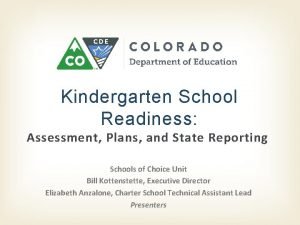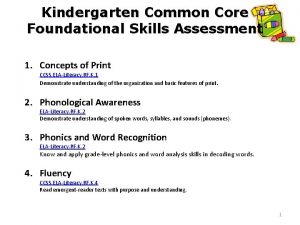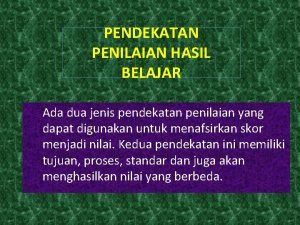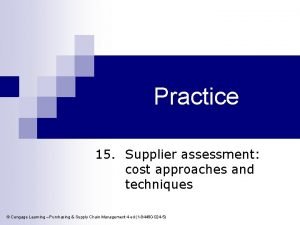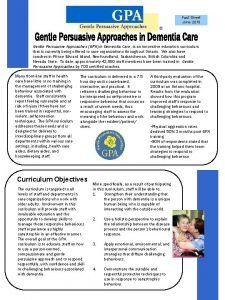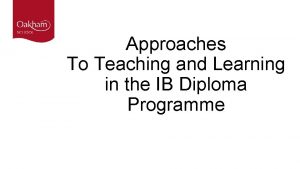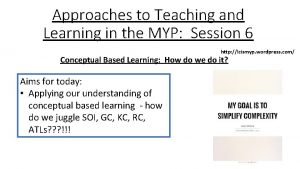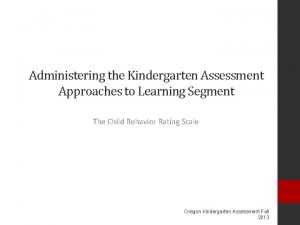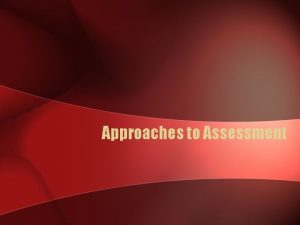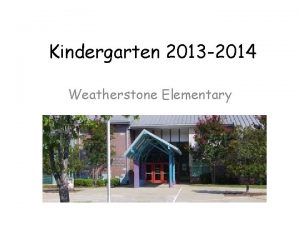2018 19 Kindergarten Assessment Approaches to Learning Training









- Slides: 9

2018 -19 Kindergarten Assessment Approaches to Learning Training Required for DTCs, STCs, and Kindergarten Teachers

Purposes of the Kindergarten Assessment • Provide local and statewide information that gives families, schools, communities, and state-level policy makers a snapshot of the social, self-regulatory, and academic skills of incoming kindergartners • Provide a consistent, statewide tool for identifying systemic opportunity gaps, determining Early Learning resource allocation to best support students in need, and measure improvement over time 2

The Kindergarten Assessment Is What it is… What it is not… A snapshot of early literacy, early math, and approaches to learning skills of students entering kindergarten NOT used to determine if an individual student can enter kindergarten A consistent, statewide tool Aligned to Early Learning and Common Core State Standards NOT a diagnostic tool for placing children in specific programs or classrooms NOT a comprehensive assessment of students’ knowledge and skills NOT designed to measure what students learn in kindergarten 3

Test Administration • Conducted through teacher observation of children’s behavior over a period of time with other adults and children in a classroom setting during the first six weeks of school • Must be completed by the classroom teacher • Includes 15 items that measure Self-Regulation and Interpersonal Skills • The classroom teacher may assess all of the students in a classroom on one item at a time or rate of each of the students on all 15 items before moving on to the next student • Special Considerations • Child’s cultural background • Very seldom children will “never” exhibit behavior described by an item 4

Scoring The teacher responds to each item by circling numbers on a 1 -5 point scale: 1) 2) 3) 4) 5) The child never exhibits the behavior described by the item. The child rarely exhibits the behavior described by the item. The child sometimes exhibits the behavior described by the item. The child frequently or usually exhibits the behavior described by the item. The child always exhibits the behavior described by the item. If the behavior was not observed, please use an item response of 6. 5

Test Attempt and Administrative Codes • The majority of your students will have a valid Attempt Code (Y) and an Administrative Code of (0) • For any student, refer to the list of Attempt and Administrative Codes at the top of the Approaches to Learning Scoresheet and record the information in the Student Information section 6

Approaches to Learning Form 7

Interpretive Guidance 8

ODE Contact Information Holly Dalton Early Literacy and Early Math Assessment Specialist • holly. dalton@state. or. us • 503 -947 -5927 Elyse Bean Kindergarten Data Owner • Elyse. bean@state. or. us • 503 -947 -5905 ODE Helpdesk Technical Assistance • ode. helpdesk@state. or. us • 503 -947 -5715 9
 Kindergarten readiness checklist colorado
Kindergarten readiness checklist colorado Kindergarten foundational skills assessment
Kindergarten foundational skills assessment Que letra continua m v t m j
Que letra continua m v t m j Oregon early learning and kindergarten guidelines
Oregon early learning and kindergarten guidelines Approaches of assessment
Approaches of assessment Supplier evaluation techniques
Supplier evaluation techniques Cuadro comparativo e-learning m-learning b-learning
Cuadro comparativo e-learning m-learning b-learning Gentle persuasive approach
Gentle persuasive approach Affective skills ib
Affective skills ib Managebac platon
Managebac platon
